Multiplicity exists in the type and number of tests that can be employed for the measurement of the blood glucose level. These tests, although vary on some points, are reliable and accurate in their working. However, the problem arises when a long-term estimation of the BGL is needed. for this purpose, an HbA1c test is utilized.
What is HbA1c?
The HbA1c or hemoglobin A1c is a test taken for the long-term estimation of the blood glucose level or BGL of a person. It is also called the glycohemoglobin test or glycated hemoglobin test.
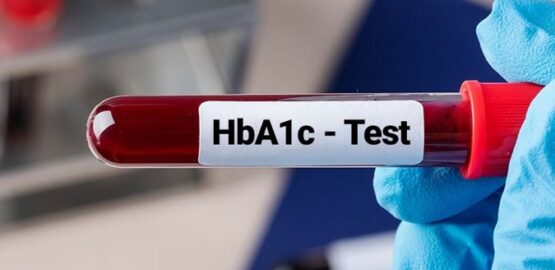
A blood sample was taken for the HbA1c test
Why is HbA1c different from other tests?
Although there are many ways to check a person’s blood glucose level, all of these tests can give the present number only i.e. the patient’s BGL at the time of taking the test can be measured but for how long that BGL has been higher cannot be quantified. The HbA1c test can tell the blood sugar level up to the past 3 months.
How does the HbA1c work?
The physiology of the glucose released from the food followed by its pathway toward the cell is as follows:
- As we take in food, our body is designed to digest it to generate numerous smaller components which are then taken into the cells for further breakdown and energy or as it is called, ATP One of these smaller entities is glucose, the well-known blood sugar which is used by the cells to generate the necessary energy needed for proper body functioning.
- This glucose, once in the blood, keeps floating until insulin is released from the pancreas which is responsible for opening the cellular gates and letting the glucose in. Once inside, the glucose, after preliminary steps, is taken to the mitochondria which are our energy-making centers.
- Although the process seems simple, the problem arises when a person does not have insulin to send the glucose into the cells e.g. in the case of diabetes mellitus. Thus, this unattended glucose will build up in the patient’s blood hence an elevated blood glucose level can be recorded.
- This glucose starts to stick up with the hemoglobin present in the red blood cells (RBCs) which is an oxygen-carrying protein. With the help of an HbA1c test, it can be estimated how much of a person’s RBCs have been coated with this glucose.
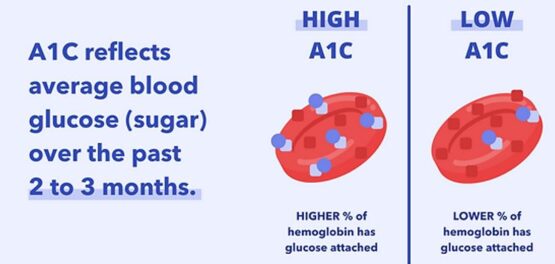
Glucose attached to the surface of the RBCs
- As the life of an RBC is 120 days or 4 months, the value of BGL measured by the HbA1c test gives an estimation of the patient’s sugar level over the past two to three months.
Who needs to take an HbA1c test?
A person needs an HbA1c test if she or he has any of the following health conditions:
- Type-2 diabetes
- Pre-diabetics
The test can also be taken as a precautionary measure if your age is above 45 years with the aim to rule out diabetes. People with a family history of diabetes should also take the test.
Moreover, if a person experiences any of the following symptoms, an HbA1c test is recommended:
- Dry skin
- Unexplained fatigue
- Slowly healing wounds or sores
- Recurring infections
- Increased hunger
- Unexplained weight loss
- Increased thirst
- Numbness or tingling of the extremities
- Frequent urination
HbA1c test kit
The rapid test kits available at Health Supply 770 for HbA1c evaluation include:
- Test instrument/Sample analyzer
- Calibration chip
- Test cassette or cartridge
- Buffer tube
- Sample dilution solution
- Dropper
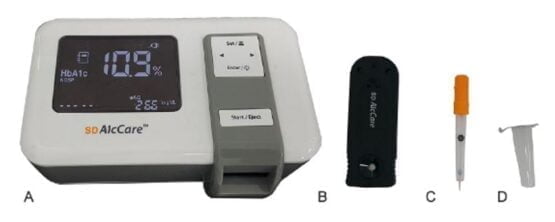
HbA1c test kit: (A) sample analyzer, (b) test cartridge, (c) dropper, and (d) buffer solution
How is an HbA1c test performed?
The HbA1c test is performed, like many other tests, by taking the patient’s blood sample which is collected and preserved for testing. This minorly invasive procedure involving the patient is merely 5 minutes. Although the test is completely safe, minor bruises may appear at the site pricked by the needle.
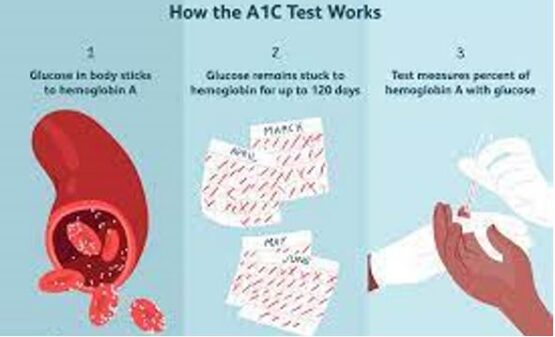
The procedure of conducting an HbA1c test
I couldn’t find its clearer version. Kindly add that or delete the picture
How to interpret the HbA1c test results?
The results of an HbA1c test are represented in percentages indicating the extent to which a person’s RBCs are coated with glucose. For the diagnosis of diabetes, the following criteria must be taken as a foundation:
| Percentage obtained after HbA1c test (%) | Interpretation |
| Less than 5.7 | Normal |
| Between 5.7 to 6.4 | Pre-diabetic |
| 6.5 or above | Diabetic |
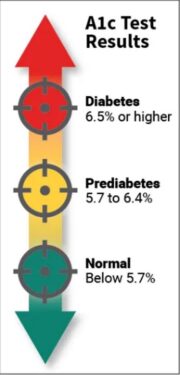
Interpretation of the HbA1c test results
4 to 5.6% of the glucose-coated RBCs is considered normal but one should be concerned if the value keeps on increasing. Here is an easy guide to estimating your blood sugar level using the results of your HbA1c test:
| HbA1c percentage (%) | Average BGL (mg/dL) |
| 4 | 68 |
| 5 | 97 |
| 6 | 126 |
| 7 | 152 |
| 8 | 183 |
| 9 | 212 |
| 10 | 240 |
| 11 | 269 |
| 12 | 298 |
| 13 | 326 |
| 14 | 355 |
Contraindications
In case of the following conditions, an HBA1c test is not recommended as these health situations interfere with the values obtained from the test thus generating false results:
- Anemia or other blood-related disorders
- Kidney failure
- Liver disorders
- Blood loss in the recent past
- Blood transfusion in the recent past
- Low iron levels
Conclusion
Among many useful tests employed for the quantification of blood sugar levels, HbA1c stands out due to its ability to estimate the glucose level over a period of the past 2 to 3 months. The test is, despite the vast difference in the results it can produce, similar to the regular BGL monitoring tests in conduction. A small amount of blood sample is needed to give the results which are recorded in percentage. Its sensitivity, as well as reliability, has rendered this test preferable to the others.

PhD Scholar (Pharmaceutics), MPhil (Pharmaceutics), Pharm D, B. Sc.
Uzma Zafar is a dedicated and highly motivated pharmaceutical professional currently pursuing her PhD in Pharmaceutics at the Punjab University College of Pharmacy, University of the Punjab. With a comprehensive academic and research background, Uzma has consistently excelled in her studies, securing first division throughout her educational journey.
Uzma’s passion for the pharmaceutical field is evident from her active engagement during her Doctor of Pharmacy (Pharm.D) program, where she not only mastered industrial techniques and clinical case studies but also delved into marketing strategies and management skills.
Throughout her career, Uzma has actively contributed to the pharmaceutical sciences, with specific research on suspension formulation and Hepatitis C risk factors and side effects. Additionally, Uzma has lent her expertise to review and fact-check articles for the Health Supply 770 blog, ensuring the accuracy and reliability of the information presented.
As she continues her PhD, expected to complete in 2025, Uzma is eager to contribute further to the field by combining her deep knowledge of pharmaceutics with real-world applications to meet global professional standards and challenges.








